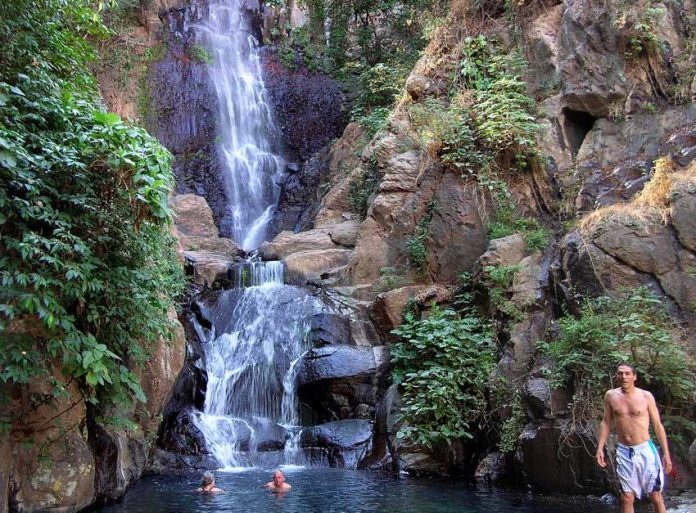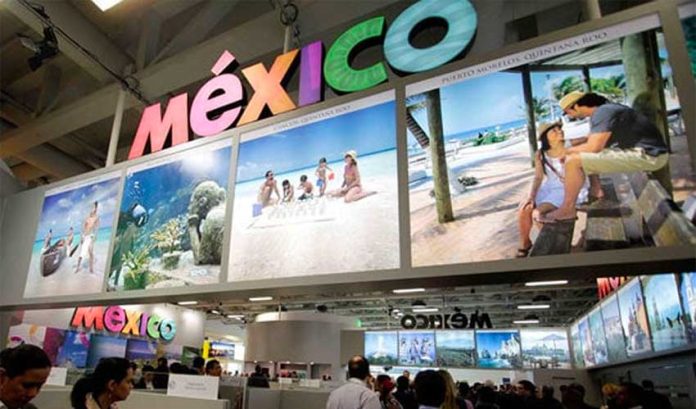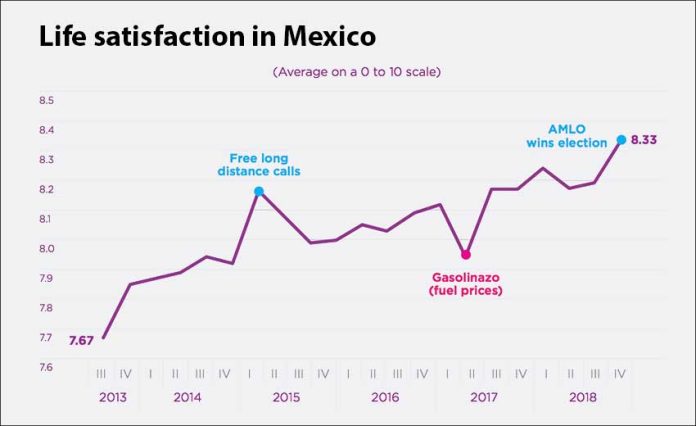Besides being the home of Mexico’s most famous drink, the town of Tequila was added to the list of the country’s Pueblos Mágicos, or magical towns, in 2003.
Although Tequila’s streets are not exactly quaint, it is surrounded by extraordinary natural beauty. On one side of town you have the massive Volcán de Tequila rising to 2,920 meters (9,580 feet) above sea level, while directly on the other side of the city lie the sheer walls of a great canyon 600 meters deep.
While cold — if not icy — winds blow at the top of the volcano, exuberant tropical vegetation flourishes on the hot and humid floor of Barranca La Toma.
Many years ago I managed to climb to the top of the far wall of La Toma canyon. Dripping with sweat and covered with dust, I gazed across the lush valley filled with the kind of jungle you’d only expect on the shores of the Amazon, and there on the opposite side, directly below the town of Tequila, I could just barely make out a tall, wispy waterfall.
“Wouldn’t it be nice to be standing at the bottom of that!” I told my friends, and thus began my 20-year search for that distant, beckoning cascade.
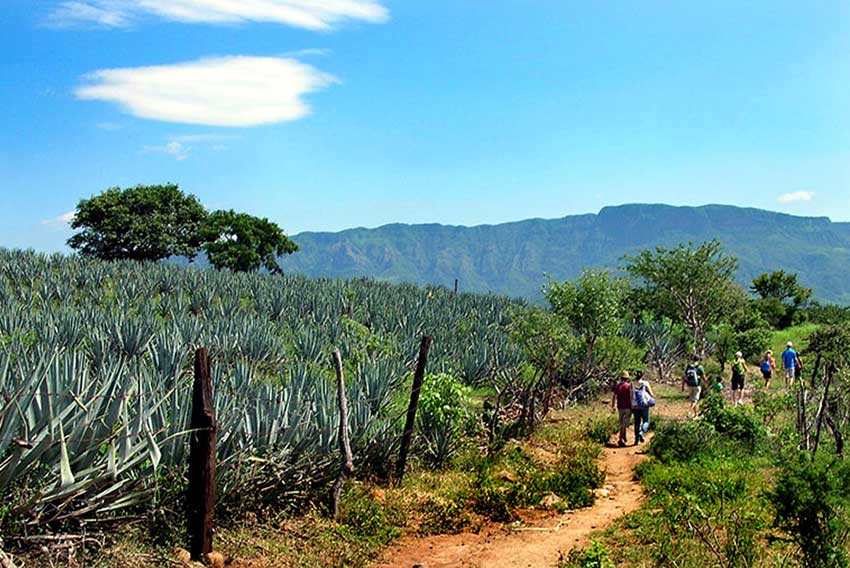
We soon learned that we what we were looking for was called Los Azules, the Blue Falls, but nobody seemed to know exactly how to get to them.
Fifteen years later, we got a clue. “You know that waterfall you’re always talking about — Los Azules? Well, I heard that the people down at Santo Toribio know how to reach it.”
I talked my wife into joining me and off we went down a very steep road to a tiny settlement at the bottom of Barranca La Toma, which boasts a grandiose church in the middle of the jungle. This is the shrine of Santo Toribio, a martyr killed in the Cristeros War.
After visiting the saint’s spartan lodgings, we mentioned Los Azules to some local children. Their eyes lit up. “We know the way — vámonos!” they said, practically dragging us on to a narrow path through an exotic landscape. Well, the path got steeper and steeper, the humidity got higher and higher, the mud got slipperier and slipperier and all of a sudden we were overlooking a chocolate-colored roaring river.
“Now what?” we asked our little guides.
“We have two choices,” they replied. “We can swim or we can try to cross the bridge.”
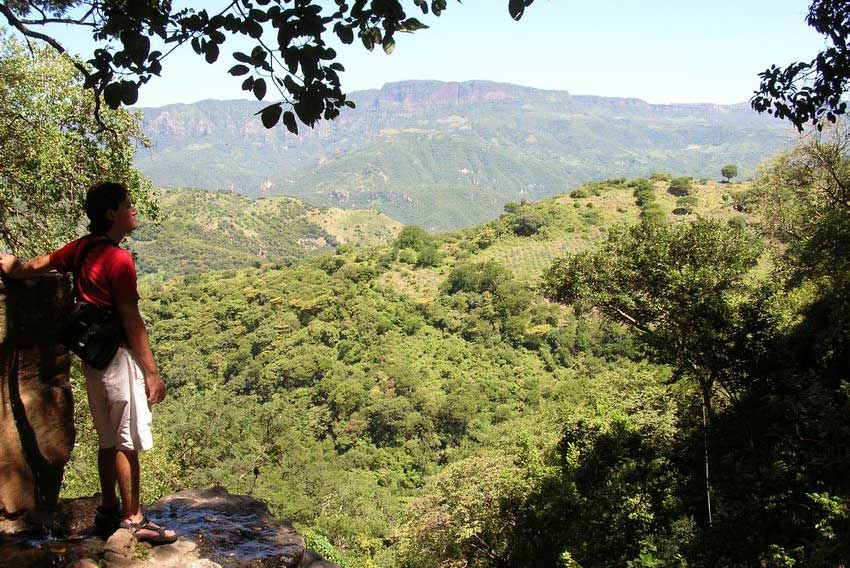
Well, the “bridge” was a precariously balanced tree trunk spanning the river which, by the way, smelled anything but inviting. Admitting that our adventurous spirit was was not quite up to the standards of those little country kids, we gave up.
That 20-year search for an easy way to reach Los Azules ended quite by accident when I bumped into canyoneering guide Luis Medina.
“John, that waterfall you’ve been calling ‘elusive’ is only a half-hour walk from Tequila — and, guess what, it’s not one waterfall but three — and all of them very impressive. I’ll show you the trail this coming Friday.”
A few days later, Luis picked me up and off we drove to Tequila. We parked only one kilometer from the highway and began walking through gorgeous fields of blue-green agaves, along a road dotted with chunks of high-quality black obsidian.
At the end of the road we had been following we started down a narrow, steep trail surrounded by jungly growth. Suddenly we came to a clearing and there, far below us in all its splendor, lay the huge valley of La Toma, framed by high, red canyon walls.
“Welcome to the Machu Pichu of Tequila,” announced Luis.
[soliloquy id="74467"]
Fifteen minutes later, we arrived at the kind of waterfall I would expect to find in the Garden of Eden. It was 40 meters tall, wide and wispy, with a sunlit blue-green pool at its foot that beckoned us to jump right in for a swim — which, of course, we wasted no time in doing. The water, by the way, comes from springs near the top of the canyon and is perfectly clean.
To our surprise, the pool temperature was neither hot nor cold, but pleasantly cool. As we swam and played in the water, dozens of blue and red dragonflies danced in the air above us, exactly like the birds and butterflies in a Walt Disney movie.
In fact, the whole scene was more like a dream than reality and to top it off, we had this paradise all to ourselves the whole time we were there, which was most of the day.
“Luis,” I said, “this is heaven! In the U.S.A. this would be a national park with no-swimming signs and hundreds of tourists filing by just to get a glimpse of paradise.”
“You know,” replied Luis, “that’s just what my clients tell me when I bring them here — these falls are even more enticing when you’re rappelling down them.”
Luis mentioned that the flow of water in Los Azules is more or less the same all year round and also during storms. This means you don’t have to worry about flash floods in this canyon, as you must in many others.
I have been describing waterfall No. 2, which is very attractive and relatively easy to reach. There are, of course, a grand total of three, which explains why the name of the place is Los Azules and not El Azul.
The first fall is around 60 meters high but only operates right after a storm while the third is 70 meters tall and, like the second, runs all year round.
My Los Azules Falls trail aims to get you to the bottom of the second waterfall, but GPS coverage is poor in this part of La Toma canyon and you might end up at any one of the three falls. Don’t worry: each of them is an adventure!
If you’d like to have Los Azules all to yourself, visit this site on a workday, not on the weekend (especially Sunday), when a lot of people from Tequila hike down to take a dip. Whatever you do, don’t forget your swimsuit and a camera!
The writer has lived near Guadalajara, Jalisco, for more than 30 years and is the author of A Guide to West Mexico’s Guachimontones and Surrounding Area and co-author of Outdoors in Western Mexico. More of his writing can be found on his website.
